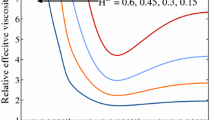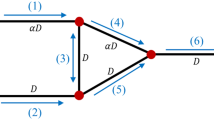Abstract
Kiani et al. (Kiani, M. F., A. R. Pries, L. L. Hsu, I. H. Sarelius, and G. R. Cokelet, Am. J. Physics. 266: H1822–H1828, 1994) suggested that blood velocity, hematocrit, and nodal pressures can oscillate spontaneously in large microvascular networks in the absence of biological control. This paper presents a model of blood flow in microvascular networks that shows the possibility of sustained spontaneous oscillations in small networks (less than 15 vessel segments). The paper explores mechanisms which cause spontaneous oscillations under some conditions and steady states under others. The existence of sustained oscillations in the absence of biological control provides alternative interpretations of dynamic behavior in the microcirculation. The model includes the Fåhraeus–Lindqvist effect and plasma skimming but no biological control mechanisms. The model is a set of coupled nonlinear partial differential equations. The equations have been solved numerically with the direct marching numerical method of characteristics. The model shows steady-state fixed point and limit cycle dynamics (sometimes showing period doubling). Plasma skimming, and the Fåhraeus–Lindqvist effect, along with arcade type topology are necessary for oscillations to occur. Depending on network parameters, nonoscillating, damped oscillating and sustaining oscillating dynamics have been demonstrated. Oscillations are damped when the residence time one of the vessels is large compared to the residence times for the other vessels. When the residence times for all vessels are comparable, sustained oscillations are possible. © 2000 Biomedical Engineering Society.
PAC00: 8719Tt, 8710+e, 0230Jr
Similar content being viewed by others
REFERENCES
Barbee, J. and G. R. Cokelet. Prediction of blood flow in tubes with diameters as small as 29 microns. Microvasc.Res. 5:17–21, 1971.
Bouskela, E. Vasomotion frequency and amplitude related to intaluminal pressure and temperature in the wing of the intact, unanesthetized bat. Microvasc.Res. 37:339–351, 1989.
Carr, R. T. and J. Xiao. Plasma skimming in vascular trees: Numerical estimates of symmetry recovery lengths. Microcirculation (Philadelphia) 2:345–353, 1995.
Cokelet, G. R. Blood flow through arterial microvascular bifurcations. In: Microvascular Networks: Experimental and Theoretical Studies, edited by A. S. Popel and P. C. Johnson. Basel, Switzerland: S. Karger AG. 1986, pp 155–167.
Cokelet, G. R. A commentary on the “in vivo viscosity law”. Biorheology 34:363–367, 1997.
Fåhraeus, R. and T. Lindqvist. The viscosity of blood in narrow capillary tubes. Am.J.Physiol. 96:562–568, 1931.
Fenton, B. M., D. W. Wilson, and G. R. Cokelet. Analysis of the effects of measured white cell entrance times on hemo-dynamics in a computer model of microvascular bed. Pflueg.Arch. 403:396–401, 1985.
Fenton, B. M., R. T. Carr, and G. R. Cokelet. Nonuniform red cell distribution in 20 to 100 mm bifurcations. Microvasc.Res. 29:103–126, 1985.
Fung, Y. C. Biomechanics: Circulation. New York: Springer, 1996.
Goldsmith, H. L. Red cell motion and wall interaction in tube flow. Fed.Proc. 30:1578–1588, 1970.
Griffith, T. M. Temporal chaos in the microcirculation. Car-diovasc.Res. 31:342–358, 1996.
Helmke, B. P., S. N. Bremnr, B. W. Zweifach, R. Skalak, and G. W. Schmid-Schonbein. Mechanisms for increased flood flow resistance due to leukocytes. Am.J.Physiol. 273:H2884–H2890, 1997.
Hoffman, J. D. Numerical Methods for Engineers and Scien-tists. New York: McGraw-Hill, 1992, pp. 825.
House, S. D. and H. H Lipowsky. Leukocyte-endothelium adhesion: Microhemodynamics in mesentery of the cat. Mi-crovasc.Res. 34:363–379, 1987.
Hsu, L. L. Mathematical Modeling of Blood Flow in Microcirculatory Networks-Relevance for Oxygen Transport. PhD thesis. New York: University of Rochester, 1988.
Intaglietta, M. Arteriolar vasomotion: implications for tissue ischaemia. Blood Vessels 28:1–7, 1991.
Johnson, P. C., and H. Wayland. Regulation of blood flow in single capillaries. Am.J.Physiol. 212:1405–1415, 1967.
Kiani, M. F. and A. G. Hudetz. A semi-empirical model of apparent blood viscosity as a function of vessel diameter and discharge hematocrit. Biorheology 28:65–73, 1991.
Kiani, M. F., A. R. Pries, L. L. Hsu, I. H. Sarelius, and G. R. Cokelet. Fluctuations in microvascular blood flow parameters caused by hemodynamic mechanisms. Am.J.Physiol. 266:H1822–H1828, 1994.
Krogh, A. Studies on the physiology of capillaries. II. The reactions to local stimuli of the blood vessels in the skin and web of the frog. J.Physiol. 55:414–422, 1921.
Minamiyama, M., and S. Hanai. Propagation properties of vasomotion at terminal arterioles and precapillaries in the rabbit mesentery. Biorheology 28:275–286, 1991.
Pries, A. R., K. Ley, M. Classen, and P. Gaehtgens. Red cell distribution at microvascular bifurcations. Microvasc.Res. 38:81–101, 1989.
Pries, A. R., T. W. Secomb, P. Gaehtgens, and J. F. Gross. Blood flow in microvascular networks. Experiments and simulation. Circ.Res. 67:826–834, 1990.
Pries, A. R., T. W. Secomb, T. Gessner, M. B. Sperandio, J. F. Gross, and P. Gaehtgens. Resistance to blood flow in microvessels in vivo. Circ.Res. 75:904–915, 1994.
Pries, A. R., D. Neuhaus, and P. Gaehtgens. Blood viscosity in tube flow: dependence on diameter and hematocrit. Am.J.Physiol. 263:H1770–H1778, 1992.
Rodgers, G. P., A. N. Schechter, C. T. Noguchi, H. G. Klein, A. W. Niehaus, and R. F. Bonner. Periodic microcirculatory flow in patients with sickle-cell disease. N.Engl.J.Med. 311:1534–1538, 1984.
Sainani, D., A. M. Barsoum, C. G. Ellis, M. F. Kiani, and G. R. Cokelet. Evidence of low dimensional chaos in a math-ematical model of microvascular blood flow in the rat mesentery. FASEB J. 8:A1056 (Abstract M147), 1994.
Schechner, J. S. and I. M. Braverman. Synchronous vasomotion in the human cutaneous microvasculature periods evidence for central modulation. Microvasc.Res. 44:27–32, 1992.
Strogatz, S. H. Nonlinear Dynamics and Chaos. Reading, MA: Addison Wesley, 1994, p. 498.
Wayland, H. and P. C. Johnson. Erythrocyte velocity mea-surement in microvessels by a two slit photometric method. J.Appl.Physiol. 22:333–337, 1967.
Author information
Authors and Affiliations
Rights and permissions
About this article
Cite this article
Carr, R.T., Lacoin, M. Nonlinear Dynamics of Microvascular Blood Flow. Annals of Biomedical Engineering 28, 641–652 (2000). https://doi.org/10.1114/1.1306346
Issue Date:
DOI: https://doi.org/10.1114/1.1306346




